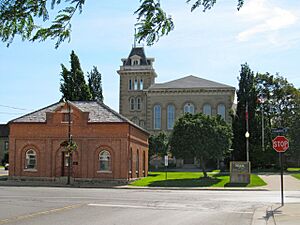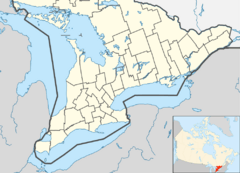Simcoe, Ontario facts for kids
Quick facts for kids
Simcoe, Ontario
|
|
|---|---|
|
Unincorporated Community in Norfolk County
|
|

Governor Simcoe Square – Main Offices of Norfolk County
|
|
| Motto(s):
Ontario's Garden
|
|
| Country | Canada |
| Province | Ontario |
| Established | 1795 |
| Amalgamated | 2001 |
| Elevation | 224 m (735 ft) |
| Population
(2021)
|
16,121 |
| Time zone | UTC−5 (EST) |
| • Summer (DST) | UTC−4 (EDT) |
| Forward sortation area |
N3Y
|
| Area code(s) | 519 and 226 |
Simcoe is a community in Southwestern Ontario, Canada. It is located near Lake Erie. Simcoe is the main town and largest community in Norfolk County. It sits where Highway 3 and Highway 24 meet. Simcoe is south of Brantford and can be reached from Hamilton using nearby Highway 6. In 2021, Simcoe had a population of 16,121 people.
Contents
Simcoe's History
Simcoe was started in 1795 by Lieutenant Governor John Graves Simcoe. At first, there were two separate areas: Birdtown and the Queensway. Birdtown was named after William Bird, who arrived in the early 1800s. The Queensway grew around Aaron Culver's saw and grist mills in the 1820s.
The post office opened in 1829 and was named Simcoe. In 1837, the village became the main government center for the Talbot District. A historical marker says that Lieutenant-Governor Simcoe gave land to Aaron Culver in 1795. This was so Culver would build mills. A small village formed by 1812, but American troops burned it down in 1814. Between 1819 and 1823, Culver planned out the village. Streets were surveyed in 1835 and 1836.
By 1846, Simcoe had a stone courthouse and jail, though the courthouse burned down in 1863 and was rebuilt. There were three churches and a weekly newspaper. The population was about 1,400. Simcoe had many important offices, including the Judge of District Court and the Sheriff. It also had mills, a brewery, stores, and a bank.
In 1850, Simcoe became the county seat of Norfolk County. Its population grew to 2,100 by 1869. Simcoe became an official town in 1878. It had its own town council and mayor until December 31, 2000. In 2001, Simcoe joined with other communities to form Norfolk County.
Norfolk County passed its first law to protect trees in 1947. This law was updated in 2000. About 350 requests to cut trees are sent to the county council each year. Over 25% of undeveloped land in Norfolk County is forest. Many of these forests are near downtown Simcoe and are open for people to explore.
Community and Culture
Notable Landmarks and Parks
One important landmark in Simcoe is the Norfolk County Carillon Memorial Tower. This tower honors local soldiers who died for Canada in wars. The Carillon Memorial Tower overlooks Wellington Park. This park is a public green space with walking paths and a small lake. It is close to the downtown area. Simcoe's main cemetery is called Oakwood Cemetery.
Local Clubs and Organizations
A cultural club for people of Croatian background operates in Simcoe. It is known as the 531st branch of the Croatian Fraternal Union. This club helps its members with expenses if they are sick and also with funeral costs.
Architecture and Buildings
The historic Molson Bank operated in Simcoe from 1898 until the 1920s. Then, the Bank of Montreal took over the building. Changes were made to the building to allow for more banking. Many of Simcoe's buildings use the International style of architecture. This style was popular between 1920 and 1950. Older homes from the 1850s use the Gothic Revival style. Some downtown buildings even mix "International" elements with the Art Deco style.
Media and Entertainment
Simcoe has a radio station, 98.9 myFM. It also has two newspapers: The Simcoe Reformer and the Norfolk News. Television stations from Hamilton, Kitchener, and Paris can be received here.
Festivals and Events
Major local festivals include the Rotary-sponsored Friendship Festival and the Norfolk County Fair and Horse Show. There is also a winter light show called Panorama. Simcoe was one of the Canadian communities where the Olympic torch passed through. This was before the 2010 Winter Olympics in Vancouver, British Columbia. The Simcoe Santa Claus Parade used to be a very big event in the 1950s. The town would stop for an afternoon for people to enjoy it. In recent years, the parade has become smaller. People now prefer warmer weather events like the Friendship Festival and the Norfolk County Fair.
Climate
Simcoe has a humid continental climate. This means it has cold winters and warm, humid summers. The average temperature in January is about -7.8°C (18°F). Most winter days stay below 0°C (32°F). However, sometimes mild weather can bring temperatures above 10°C (50°F) in January. The average yearly snowfall is about 133 cm (52 inches).
Summers are warm and humid. The average high temperature in July is about 27°C (81°F). Temperatures above 30°C (86°F) happen about 10 days each year. Simcoe gets about 1010 mm (40 inches) of rain and snow each year. This is spread out fairly evenly throughout the year. Simcoe gets about 2021 hours of sunshine per year.
The hottest day ever recorded in Simcoe was August 28, 1973, at 36.1°C (97°F). The coldest day was January 18, 1976, at -29.4°C (-21°F). Simcoe is generally drier than larger cities like Toronto and Hamilton. It also has much less smog during the summer months. Sunny days tend to last longer, which is nice for summer.
Demographics
| Town of Simcoe | ||
|---|---|---|
| Year | Pop. | ±% |
| 1871 | 1,856 | — |
| 1881 | 2,922 | +57.4% |
| 1891 | 2,674 | −8.5% |
| 1901 | 2,627 | −1.8% |
| 1911 | 3,227 | +22.8% |
| 1921 | 3,953 | +22.5% |
| 1931 | 5,226 | +32.2% |
| 1941 | 6,037 | +15.5% |
| 1951 | 7,269 | +20.4% |
| 1956 | 8,078 | +11.1% |
| 1961 | 8,754 | +8.4% |
| 1966 | 9,929 | +13.4% |
| 1971 | 10,793 | +8.7% |
| 1976 | 14,189 | +31.5% |
| 1981 | 14,326 | +1.0% |
| 1986 | 14,290 | −0.3% |
| 1991 | 15,539 | +8.7% |
| 1996 | 15,380 | −1.0% |
| 2001 | 14,941 | −2.9% |
| Population centre | ||
|---|---|---|
| Year | Pop. | ±% |
| 2006 | 14,522 | — |
| 2011 | 14,777 | +1.8% |
| 2016 | 13,922 | −5.8% |
| 2021 | 16,121 | +15.8% |
In the 2021 census, Simcoe had a population of 16,121 people. This was a 15.8% increase from its 2016 population of 13,922. Simcoe covers an area of 16.50 square kilometers (6.37 square miles). This means there were about 977 people per square kilometer in 2021.
Housing and Life in Simcoe
The average age of a Simcoe resident in 2011 was 48 years old. Most people in Simcoe speak English. A small number of residents also speak Ojibway and some Eastern European languages.
Transportation and Tourism
In 1886, the South Norfolk Railway built a train line that stopped in Simcoe. This train ran until 1965. Train services in Norfolk County ended because of economic reasons and rising fuel costs.
A local transit program called Ride Norfolk helps people travel around Norfolk County. This program is based in Simcoe. There are 50 hotels and bed and breakfast places near downtown Simcoe. Prices for these places change depending on the season.
A country club called the Norfolk County Golf and Country Club was started in Simcoe in 1895. At first, women were not allowed to be members, and certain alcoholic drinks were not permitted. In 1912, the club changed its rules. Ladies could then access the facilities for a fee, and gentlemen paid more for full membership. This country club is still open today.
Employment
Simcoe is seeing more jobs and a growing population. Many rural Canadian towns struggle with jobs and transportation. But Simcoe is doing well because of its good infrastructure. Its location close to bigger cities also helps. This means Simcoe is likely to have a strong economy for many years.
Manufacturing Jobs
One of the first manufacturers in Simcoe was the West & Peachey Company. This company made equipment and boilers. They invented a special steamboat called an Alligator. This boat was used by logging companies across Eastern North America starting in 1878. The company built 230 of these "alligator tugs" between 1889 and 1932.
In 1929, American Can Company started making cans in Simcoe. This factory employed many local people for 42 years. The Canadian Canning Company, which made canned fruits and vegetables, was a big customer. It used local produce. The American Can plant closed in 1991, partly due to an economic slowdown. At its busiest, the plant employed 605 men and 39 women. During World War II, many women worked full-time at the plant. This was because many men had gone to fight in the war. The plant continued to make cans for food and special packaging for the war effort.
Small factories used to be common in southeastern Simcoe. But in the early 2000s, many high-paying manufacturing jobs moved to countries like China and Bangladesh. This was a common trend across Ontario. In 2011, about 11.1% of Simcoe's workers were in manufacturing. This was a little higher than the average for Ontario. In 2018, Toyotetsu announced a large expansion of its factories in Simcoe. Their first plant, built in 2006, makes metal parts for cars. It employs about 170 full-time people. Toyotetsu has continued to grow its production in Simcoe.
Notable People
Simcoe has been home to many talented people in different fields.
Arts
- Bruce McCall: A Canadian artist and writer known for his work in The New Yorker magazine. He wrote about his childhood in Simcoe in his book Thin Ice.
- Stella Asling-Riis: A novelist and writer who was born in Simcoe.
- Deborah Ellis: A famous writer who has won many awards for her children's books. She lives in Simcoe.
- Ronald Beckett: A Canadian composer, conductor, and founder of the Arcady Ensemble.
Education
- R. Scott Bakker: A Canadian fantasy author.
- David Strangway: A Canadian geophysicist.
Entertainment
- Rick Danko: A musician known for his work with Ronnie Hawkins and The Band.
- Terry Danko: A musician who played with many famous artists like George Harrison and Bob Dylan.
- Margo Davidson: A musician from the band The Parachute Club.
Military
- James Sutherland Brown: A senior officer in the Canadian military during the First World War.
Science
- Alfred H. Bell: A petroleum geologist.
Sports
- John Axford: A baseball player.
- Rob Blake: A hockey player.
- Annaleise Carr: A swimmer.
- Jassen Cullimore: A hockey player.
- Red Kelly: A hockey player.
- Ryan Lindsay: A hockey player.
- Andrew Penner: A hockey player.
- Dwayne Roloson: A hockey player.
- Jack Roxburgh: A former president of the Canadian Amateur Hockey Association.
- H. J. Sterling: A former president of the Canadian Amateur Hockey Association.
- Ryan VandenBussche: A hockey player.
- Rick Wamsley: A hockey player.


